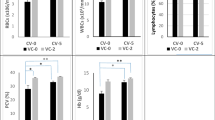Abstract
Twenty-four male adult albino rats, weighing between 130 and 239 g, were randomly divided into four groups of six rats per group (A to D). The rats were fed either normal pelleted commercial feed containing 14.5% crude protein alone (group A) or feed supplemented with pulverized dry leaves of Codiaeum variegatum (garden croton) at the levels of 0.25% (B), 0.5% (C), and 1.0% (D). All four groups of rats were fed for 12 weeks, during which period clean water was provided ad libitum. Every 2 weeks, body weights of individual rats were taken and blood collected for hematology (packed cell volume (PCV), total and differential leukocyte counts). Hemoglobin concentration was determined at 4-week intervals. At the end of the 12-week study period, all rats were sacrificed; testes and epididymes of individual rats were weighed separately to calculate the organosomatic index for both organs. Thereafter, testicular and epididymal sperm counts were performed. Supplementing rat feed with C. variegatum leaves in treated groups (B, C, and D) resulted in reduced weight gain such that by the 12th week of study, the mean body weight of group D rats was significantly lower than that of the unsupplemented control (group A) rats. The testicular and epididymal organosomatic index for the different treatment groups were not significantly (P > 0. 05) different from the mean values for group A rats. The hematological evaluation of the rats showed that supplementation at any of the level used did not significantly (P > 0. 05) alter the mean PCV values. The mean total leukocyte and the mean absolute neutrophil counts (by the fourth week) for the treated groups were significantly (P < 0. 05) higher than the corresponding values for the control groups. Likewise, the mean hemoglobin concentration for the treated groups was only slightly lower than the mean values for the control group for the greater part of the study period. The mean testicular sperm counts for the treated rat groups were generally lower in a dose-dependent manner, but was not significantly different (P > 0.05) from the mean values for the control group. On the other hand, the mean epididymal sperm counts for the treated rat groups were significantly (P < 0. 05) lower than the mean values for the control in a dose-dependent pattern. This study has shown that feeding male rats in particular and probably other animals in general on the leaves of garden croton at a level as low as 0.25% level of supplementation has the tendency to stimulate the immune function of animals but could severely reduce the testicular and epididymal sperm reserve counts, thereby reducing the reproductive efficiency of male animals. These results recommend further studies in respect to the immunostimulating and spermatotoxic properties of the leaves of this plant.
Similar content being viewed by others
References
Abebe D, Urga K, Debella A, Ambaye C, Dejene A (2001) Traditional uses of Qulqwal complex (members of Euphorbiaceae family) as possible risk of carcinogenicity. J Ethiop Med Pract 3(1):27–29
Ahmed OMM, Adam SEI (1979) Toxicity of Jatropha cureas in sheep and goats. Res Vet Sci 27:89–92
Ammann A, Burrowes S (2006) Use of total lymphocyte count vs CD4 cell count as a marker of immunity in HIV-infected adults and children. www.womenchildrenhiv.org
Bukhiet AO, Adam SEI SEI (1996) Toxicity to Bovans chicks of Vassia italic seeds. Phytother Res 10:156–160
Cassidy SL, Dix K, Jenkins T (1983) Evaluation of a testicular sperm head counting technique using rats exposed to dimethoxy-ethylphthalate (DMEP), glycerol a-monochlorohydrin (GMCH), epichlorohydrin (ECH), formaldehyde (FA), or methyl metanesulphonate (MMS). Arch Toxicol 53:71–78
Coles HE (1986) Veterinary chemical pathology, 4th edn. Saunders, Philadelphia, p 12
El Badwi SMA, Adam SEI, Hapke HJ (1992) Toxic effect of low levels of dietary Jatropha cureas seed on Brown Hisex chicks. Vet Hum Toxicol 34:112–115
El Mekkawy S, Meselhy MR, Nakamura N (2000) Anti HIV-1 phorbol ester from the seeds of croton tiglium. Phytochem 53(4):457–464
Evans FJ, Soper CJ (1978) The tigliane, daphnane and ingenane diterpene, their chemistry, distributions and biological activities. A review. Lioydia 41:193–233
Fuller TC, McClintock E (1986) Poisonous plants of California. University of California Press, Berkeley, p 432
Goldstone RT, Wilkes RD, Seybold IM (1980) Evaluation of the leucocytes: morphology, production, malnutrition and function. The Basic Clin Path Lab 8, 75(8):1233–1239
Guyton AC (1981) Textbook of medical physiology, 6th edn. Saunders, Philadelphia, pp 902–903
International Council for Standardization in Haematology (ICSH). In: Guidelines on Standard Operating Procedures for Haematology; Haemoglobinometry. WHO 1965. www.Searo.who.int/EN
Linder PE, Hess RA, Perreault SD, Strader LF, Babee RR (1988) Acute effect and long-term sequelae of 1, 3-dinitrobenzene on male reproduction in the rat 1. Sperm quality, quantity and fertilizing ability. J Androl 9:317–326
Obidike IR, Igwebuike UM, Shoyinka SVO (2007) Testicular morphology and cauda epididymal sperm reserves of male rats exposed to Nigerian Qua Iboe Brent crude oil. J Vet Sci 8:1–5
Oishi S (2002) Effects of propyl paraben on the male reproductive system. Food Chem Toxicol 40:1807–1813
Sutovsky P, Moreno R, Ramahlho-Santos J, Dominko T, Thompson W (2001) A putative ubiquitin-dependent mechanism for the recognition and elimination of defective spermatozoa in the mammalian epididymis. J Cell Sci 114(9):1665–1675
Taylor L (1999) Message from Leslie Taylor. Raintree nutrition. Data entry for Aveloz—Euphorbia tirucalli. http://ip.aaas.org/tekindex.nsf
Vogg G, Mattes E, Polack A, Heinrich S (1999) Tumor promoters in commercial indoor-plant cultivars of the Euphorbiaceae. Environ Health Persp 107:753–756
Author information
Authors and Affiliations
Corresponding author
Rights and permissions
About this article
Cite this article
Olumuyiwa, S.S.V., Obidike, I.R. & O., O.S. Effect of experimental feeding of Codiaeum variegatum leaves on growth, hematology, gonadal, and extra-gonadal sperm reserves of adult albino rats. Comp Clin Pathol 19, 21–27 (2010). https://doi.org/10.1007/s00580-009-0894-8
Received:
Accepted:
Published:
Issue Date:
DOI: https://doi.org/10.1007/s00580-009-0894-8




